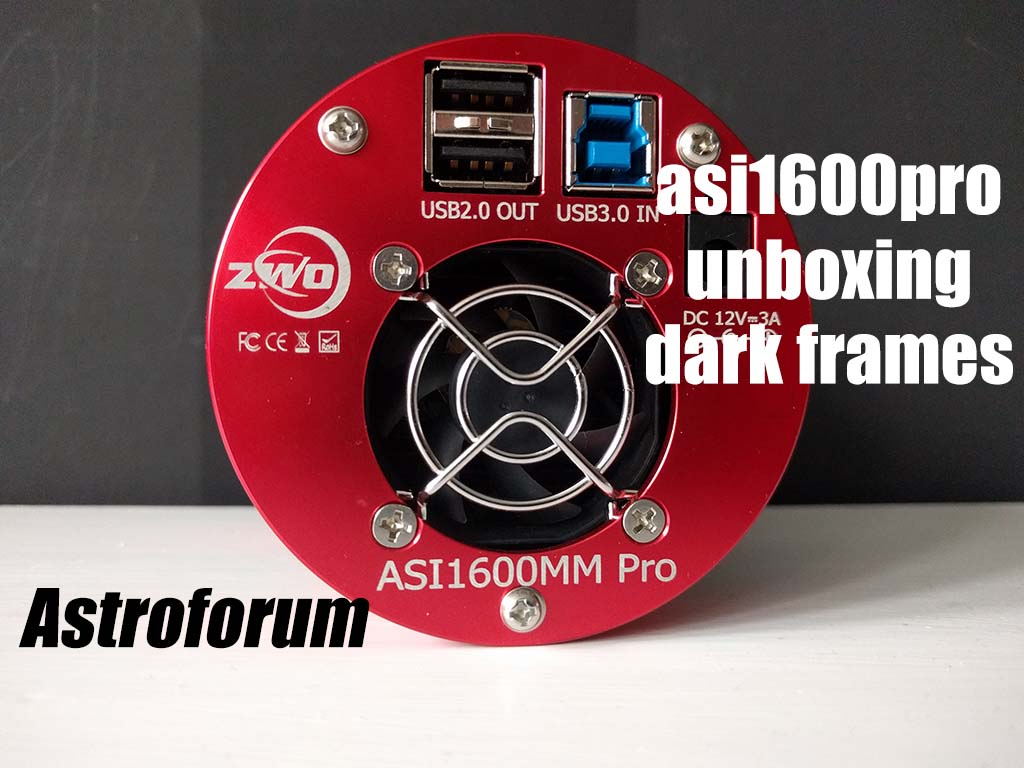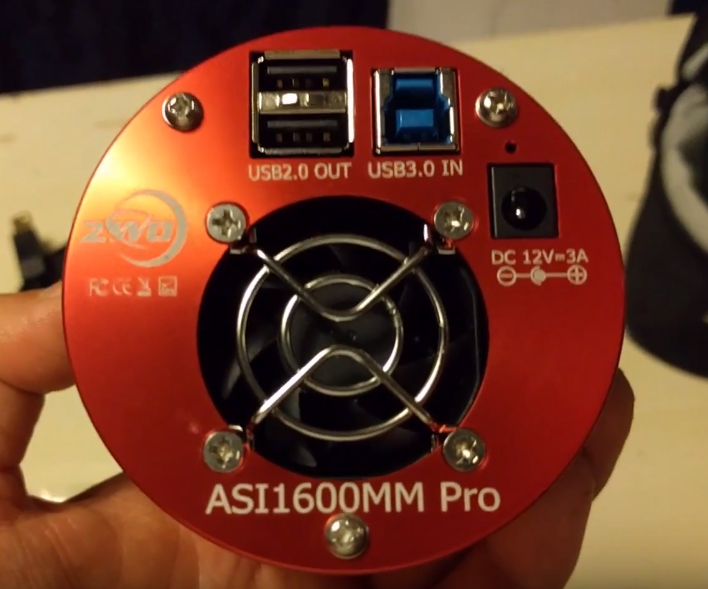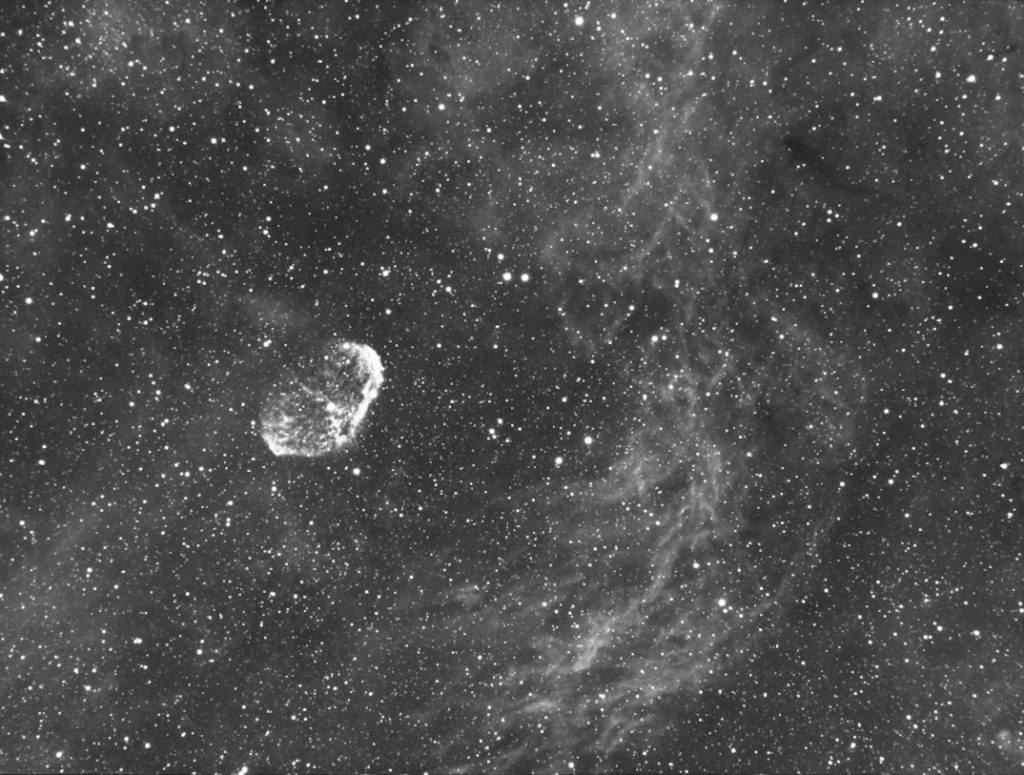
I always wanted to review a dedicated deepksy astrophotography camera like the ZWO ASI 1600MM Pro. Now that I finally took the plunge and bought this camera for my own astrophotography, I’m happy to share my experiences with you in this review.
The short conclusion of my review is that the ZWO ASI 1600MM pro camera is one of the best CMOS astrophotography cameras I’ve used to date. I’m very impressed with the quality of the images produced by this camera. My dark frame tests showed that the camera produced almost no noise or amp glow. Moreover, the large sensor on the ZWO ASI 1600MM pro allows you to capture large deep sky objects with an incredible amount of detail. If this is your first mono camera, it is important to mention that you will need to use various astrophotography filters, and probably a filterwheel, to create a colored image of your deepsky object. Using a mono camera also means that you will triple the time spent on your deepsky object as compared to using a color camera. If you are a patient person, the extra capturing time and more complex post processing to integrate the images from various filters is more than worth it though. You will end up with some of the best quality astrophotography pictures you’ve ever created!
ZWO – the company
ZWO is a company that is innovating at a great pace. Their cooled CMOS cameras are a most welcome addition to the market, especially because the price range of their cooled CMOS cameras are much more favorable as compared to a CCD camera. I bought my ZWO ASI 1600MM pro in September, hoping that this camera would considerably increase the quality of my images as compared to my DSLR camera – my astromodified Canon Rebel T5. One of the biggest advantages of the ZWO 1600MM pro is its cooling option to -45C degrees below ambient temperature, which should greatly reduce any kind of noise. This is important, because the noise in your picture when using a normal DSLR camera – which also holds a CMOS sensor – is often difficult to calibrate out when post-processing your astrophotography images – especially when your pictures are taken on hot summer nights. Before getting into my test results, let me first tell you what you can expect to get when buying the ZWO ASI 1600MM pro.
What’s in the box?
I ordered the ZWO ASI 1600MM pro directly from ZWO cameras (China). I waited for a few weeks before the camera was delivered (I live in The Netherlands, Europe). The box of the camera looked nice and contained the following materials; a nice little bag, one USB 3.0 cable, two USB 2.0 cables and some spacers. The included USB 3.0 cable is designed for connecting the camera to your PC or laptop, whereas the USB 2.0 cables can be used to power and connect an optional filterwheel and/or your guide camera. Importantly, the camera was delivered without an adapter. ZWO recommends using a 12V/3-5A or more DC adapter for cooler power supply (2.1×5.5, center positive), or using a battery with 9-15V for powering the cooler, which you have to buy separately. I got mine for about 15 euro’s (about 17 USD).

Inputs and outputs on the ZWO 1600MM pro
The back of the camera provides one USB 3.0 input, two USB 2.0 outputs, and one DC output for the adapter. I was especially happy with the extra USB 2.0 outputs, which means that i can power my filterwheel and guidecam without running two extra USB 2.0 cables to my laptop or computer.

CMOS sensor and memory
One beautiful thing about the ZWO ASI 1600MM pro is the very large CMOS sensor. The MN34230 CMOS sensor comes with a resolution of 4565*3520 and has a 3.8um pixel size, which makes it a great camera for imaging widefield objects with a widefield refractor. To give you an impression, the ZWO ASI 1600MM PRO mounted on my 80mm APO refractor telescope gave me a field of view of 2 by 1.5 degrees. Such a field of view is perfect when you want to capture large nebula, such as the Orion nebula (M42), the Horsehead nebula (Barnard 33), or the Andromeda Galaxy (M31). The camera also contains DDR3 256MB memory, which should help to improve data transfer reliability and minimize amp glow caused by a slow transfer speed when using a USB 2.0 port on your laptop or computer to connect the camera. Moreover, the camera has a low read noise of 1.2e.
Testing noise and ampglow levels
One thing that concerned me was the possibility of amp glow. I especially had some bad experiences before with the ZWO ASI 178 MC-cool, you can find my review on this camera here. The main disadvantage was that this camera suffered from some serious amp glow in the right upper corner when using shutter times above 90 seconds. So was anxious to find out whether the amp glow would be as bad as with the ZWO ASI 178MC Cool. So the first thing i did was taking some dark frames and check the amount of noise and amp glow at various exposure times, while cooling the camera down to -25 degrees celcius (77 degrees fahrenheit) at unity gain (139) setting. Below, you can see a dark frame – taken with the lenscap on – with an exposure time of five minutes.

I was relieved to conclude that after five minutes, the frame showed a pitch-black image, without any noticeable noise or amp glow. The second, stretched, image revealed a small amount of amp glow at the right upper and lower corners of the picture. But this was not nearly as problematic as compared to the ZWO ASI 178MC-cool. I was actually positively surprised with these results. Of course, we are still dealing with a CMOS sensor. As such, the picture below, where I zoomed in on the top right corner at 400%, clearly shows some noise.

I also stacked 50 images of 300 seconds, cooled at -25 celcius as a master dark frame. Again, I stretched this picture in Sequence Generator Pro and zoomed in on the upper right corner. I was pleasantly surprised as I noticed that the noise was substantially reduced as compared to the single dark frame.

First light!
As always, I had to wait for a couple of nights for first light, as buying new equipment always seems to coincide with some cloudy days. I had a rather challenging first session ahead, because switching to a mono camera also meant that I had to use a filterwheel and new software (Sequence Generator Pro). Moreover, I had to re-align my field flattener to reduce spherical aberrations at the edges of the image as I’m using an APO refractor (more on that in another blog). After setting everything up, my first session went surprisingly well! I chose to target the Crescent Nebula (NGC6888) and used narrowband filters (Ha, Sii, Oiii) – another first – in order to overcome the light pollution from the city lights and my neighbour who loves to keep the light on in his garden at night :-). I decided on taking 300 second HA, Sii and Oiii frames. The first Ha frame came out surprisingly well. The Crescent Nebula was clearly in the field of view, and because of the large sensor on the 1600MM pro, the image also captured the nebulosity around the nebula very well.

During this first imaging session, I ended up taking 36Ha, 16 Sii, and 16 Oiii frames. I stacked the 36Ha images in Deep Sky Stacker while compensating for flats, darks and bias frames. The result was pretty impressive. Despite being in a red zone (Bortle class 8 skies), the stacked Ha image clearly showed the Crescent Nebula in great detail.

NGC6888 zoomed from the above stacked Ha image
Finally I combined a first Ha, SII, OIII (SHO) narrowband image of the cresent nebula. Please keep in mind that this is was my very first time that I’d ever attempted to combine narrowband images into one astrophotography picture. If you are interested in the capabilities of the ZWO 1600MM pro, I encourage you to look at my gallery. Almost all of the pictures are taken with the ZWO ASI 1600MM pro.

Combined image of Ha, Sii, Oiii as RGB using photoshop
Summary
All in all, I was pretty impressed with the quality of the images produced by my ZWO ASI 1600MM pro. The camera is quite a step up in quality – especially from a regular DSLR camera such as my old trusted Canon Rebel T5. I especially like the fact that the camera produces almost no noise or amp glow. Moreover, the large sensor enables you to capture large objects in high detail, including the smaller objects that are in the field of view. Using a mono camera is a step up in terms of complexity as you need to learn how to use a filterwheel and new capturing software. If you are used to imaging in color, you also need to wrap my head around how to stack and combine the separate RGB images in Photoshop. But actually, that is also what makes our hobby so exciting. I remember starting out with binoculars, buying my first telescope (a refractor), learning how to autoguide with an equatorial mount, and so on. This is another step up, and it opens up a new range of objects that you will be able to capture in great detail using this awesome camera. Of course, I encourage you to do your own research! Don’t take my word for it, just collect as much information as possible before making a decision on how to spend your precious money.
The ZWO ASI 1600MM pro is available here:
Video reviews of the ZWO 1600MM pro
If you didn’t already, you can also click on the video’s below where I review the ZWO ASI 1600MM pro. These were some of my first youtube video’s so bear with me :-)!
First light video of the ZWO 1600MM pro
Hi Wido, many thanks for all the info you are sharing in your blog. I have similar gear to what you have and I have specific question re exact setup for EdgeHD 800 + ASI 1600mm Pro + ASI EFW. Are you able to obtain the targeted back focus of 133.5 mm? Thanks in advance for the response.
Hi Adam,
Sorry for the late reply. Yes, I have the filterwheel and camera at the recommended 105mm backfocus (not 133.5). See: https://s3.amazonaws.com/celestron-site-support-files/support_files/94242_reducer_inst_sheet.pdf